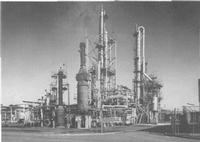


Chapter 9
I Introduction
II The Australian Chemical Industry
III Pharmaceuticals
IV Chemists In Other Industries
V The Dawn Of Modern Chemical Industry - High Pressure Synthesis
VI The Growth Of Synthetic Chemicals - Concentration, Rationalisation And International Links
VII Australian Industrial Chemical Research Laboratories
VIII The Plastics Industry
i Plastics processing
ii Phenol - basis of the first plastic
iii Plastics - the first generation
iv Plastics - the second generation - from petrochemicals
v Styrene monomer - the West Footscray petrochemical complex
vi The Botany petrochemical complex
vii The petrochemical complex at Altona
viii CSR - from sugar alcohol to petrochemical OXO alcohol
IX The Paint Industry
X Acknowledgements
References
Index
Search
Help
Contact us

Styrene monomer - the West Footscray petrochemical complex
In 1958 Universal Oil Products (UOP), a highly regarded US research and development organization specialising in refinery processing, announced a new process which permitted the alkylation of benzene with dilute ethylene gas. The resultant product, ethylbenzene, is the essential intermediate in the manufacture of all commercially produced styrene monomer. Previously ethylbenzene manufacture had required concentrated (95 per cent) ethylene, which was reacted with benzene in the presence of aluminium chloride catalyst. This catalyst is highly corrosive and requires expensive, acid resistant equipment. The new UOP process employed an entirely new catalyst and the reaction could be carried out in mild steel equipment.Monsanto, the largest consumer of styrene monomer in Australia and with access to its parent company's technology saw in the new process an opportunity to combine the raw material advantages of PACCAL with its own technology and market strengths. A joint venture company Australian Petrochemicals Ltd. (APL) was formed, with Monsanto holding 55 per cent and PACCAL 45 per cent of the equity. APL became the first licensee of the new UOP process (tradenamed 'Alkar'). Construction of the plant commenced in 1959 and it was brought on stream in 1961 (Fig. 26).

The new process was not without its teething problems. The catalyst was extremely sensitive to even traces of water, and extreme precautions were required to ensure dry feedstocks and recycle streams. New sampling and analytical techniques had to be developed. A persistent problem with catalyst poisoning was eventually traced to water found in a hitherto unsuspected reaction between acetylene and carbon monoxide. (Process development work by UOP had indicated acetylene would be converted quantitatively to diphenylethane.) Despite these problems the operation was both a technical and financial success and the plant was 'debottlenecked' by a variety of improvements to almost three times its design capacity. By 1972 it had become clear that PACCAL's life as a gas producer was limited; supply of natural gas to the Sydney area was in sight, new processes for the reforming of naphtha to fuel gas were available, and PACCAL was experiencing problems in meeting the increasingly stringent environmental discharge standards. The oil crisis of 1973, with the resultant fivefold increase in oil prices dealt the coup de grace, and PACCAL and APL shut down early in 1974.
Convinced of the strategic benefits in a country like Australia of dilute ethylene as a feedstock, but conscious also of the shortcomings of the 'Alkar' process, Monsanto undertook research on the conventional aluminium chloride alkylation process to determine whether it could be adopted economically to the use of dilute ethylene. Results were very satisfactory. In the meantime, discussions had commenced with BHP on a new styrene monomer venture. A highly integrated operation was envisaged, using as basic feedstocks ethane from Bass Strait and coke oven light oil (principally benzene, toluene and xylene, BTX) from BHP's steel works at Newcastle and Port Kembla. The ethane would be cracked in conventional furnaces to provide a dilute ethylene stream for benzene alkylation. By-product hydrogen would be fed to a hydrodealkylation unit to convert the BTX into benzene. Ethylbenzene would be converted to styrene monomer using standard Monsanto technology.
Organisations in Australian Science at Work - Australian Petrochemicals Ltd (A.P.L.); Boral; Monsanto Australia; Petroleum and Chemical Corporation (Australia) Ltd (P.A.C.C.A.L.)
 |
Australian Academy of Technological Sciences and Engineering |  |
© 1988 Print Edition pages 700 - 701, Online Edition 2000
Published by Australian Science and Technology Heritage Centre, using the Web Academic Resource Publisher
http://www.austehc.unimelb.edu.au/tia/668.html